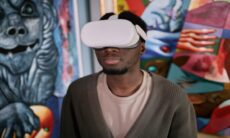Xreal partners with Google to develop Android XR glasses
A Chinese augmented-reality specialist, Xreal, is moving towards a large-scale commercial debut of lightweight smart glasses created for Google’s new Android XR software platform. According to the company’s co-founder and chief scientist, internal schedules point to shipments beginning as early as the first quarter of 2026, placing the product in direct competition with forthcoming devices from Apple and Meta Platforms.
The project, internally labelled Project Aura, was introduced during Google’s I/O developer gathering in May 2025. Google has adopted a familiar playbook: it will supply the operating system while delegating hardware construction to an external manufacturer, in this case, Xreal, the firm formerly known as Nreal. The approach echoes the company’s earliest Android smartphone strategy and follows a separate Google mixed-reality effort called Moohan, an ongoing collaboration with Samsung Electronics on a standalone virtual-reality headset that is expected to rival Apple’s Vision Pro.
Project Aura’s headline specification is a field of view exceeding 70 degrees, which Xreal describes as the largest visual canvas it has built to date. The optical module employs thinner, custom-engineered lenses that expand the viewing envelope without increasing bulk. Processing duties are split between a Qualcomm Snapdragon system-on-chip and Xreal’s in-house X1S companion processor. The X1S is an evolution of the X1 spatial-computing chip that debuted in late 2024 inside the Xreal One, offering faster memory pathways, refined thermal management and lower power draw to accommodate the heavier data throughput required by Android XR.
Google’s decision to opt for a dual-chip configuration mirrors Apple’s Vision Pro, which pairs an M2 application processor with a bespoke R1 coprocessor. By dividing general computing tasks from sensor-fusion and display control, both companies aim to reduce latency and extend battery life, key hurdles for all-day wearable devices.
Although Xreal has not released formal volume projections, preliminary cost modelling indicates that Aura will carry a premium over today’s augmented-reality headsets yet remain cheaper than top-tier virtual-reality models. For context, Xreal’s current flagship, the One Pro, sells for US$599, while Apple prices the Vision Pro at US$3,499. Industry observers therefore expect Aura to slot somewhere between these two points, broadening its potential audience.
Negotiations with Google began in early 2024 and produced a demonstrator that secured approval from senior executives later that year. Engineers are now refining both hardware and software integration. Android XR provides native hooks into Google services such as Search, Maps and YouTube, and the operating system taps the Gemini multimodal AI engine to enable advanced hand-gesture recognition, eye-tracking and context-aware assistance.
Xreal was founded in 2017 by Zhejiang University alumni Wu Kejian, Xu Chi, and Xiao Bing. Since launch the firm has shipped more than 600,000 devices globally and is targeting annual volumes above one million units within the next two to three years. Management says the business is approaching break-even and has started exploratory work towards an initial public offering.
The company is also redoubling efforts to localise its supply chain amid heightened geopolitical uncertainty, while simultaneously diversifying sales channels across the United States, China, Japan and Europe. Executives have speculated that Chinese technology groups could, in time, develop operating systems with almost similar features to Android XR, a move that would reshape competitive dynamics.
The extended-reality (XR) industry has experienced repeated boom-and-bust cycles, from early virtual-reality hype through the metaverse surge to Apple’s recent headset launch, yet mass adoption remains elusive, constrained by high component costs, limited battery endurance and a shortage of compelling software. Analysts argue that rapid advances in artificial intelligence frameworks could provide the missing catalyst by simplifying user interaction and unlocking new applications.
Evidence of rising consumer interest is emerging. Meta’s Ray-Ban smart glasses, which rely on AI voice control rather than integrated displays, have surpassed two million units since October 2023. Chinese manufacturers are following suit: Huawei Technologies, Rokid, Xiaomi, Baidu, Meizu, and Rayneo have all announced or released AI-enhanced eyewear this year. Xiaomi’s latest model, for example, entered the domestic market at 1,999 yuan (approximately US$279), and Hangzhou-based Rokid started shipping payment-enabled glasses at the end of June.
Market-tracking house IDC recorded global smart eyewear shipments of 1.487 million units in the first quarter of 2025, an 82.3 per cent year-on-year rise. Chinese volumes climbed even faster, up 116.1 per cent to 494,000 units, with full-year numbers forecast to reach nearly 2.9 million.
Within the sector, Xreal’s co-founder Xu Chi has proposed a five-level taxonomy for AI glasses, with Level 2 devices, capable of photography, video capture, conversational AI and real-time translation, becoming the norm in 2025. He predicts that true mainstream uptake will occur in 2027 when higher-resolution displays and richer multimodal AI converge.
By pairing Android XR’s software ecosystem with its own optical and silicon expertise, Xreal aims to deliver a product that balances performance, weight and cost more effectively than earlier attempts at consumer mixed-reality hardware. If the partnership with Google repeats the success of Android’s early smartphone collaborations, Project Aura could accelerate the transition of augmented-reality eyewear from niche curiosity to everyday tools.
Xreal’s leadership argues that sustained innovation, particularly in AI integration, will provide the resilience required to navigate the sector’s cyclical nature. With prototype validation complete and supply-chain localisation underway, the company is positioning itself to capture the next wave of growth in intelligent eyewear.










